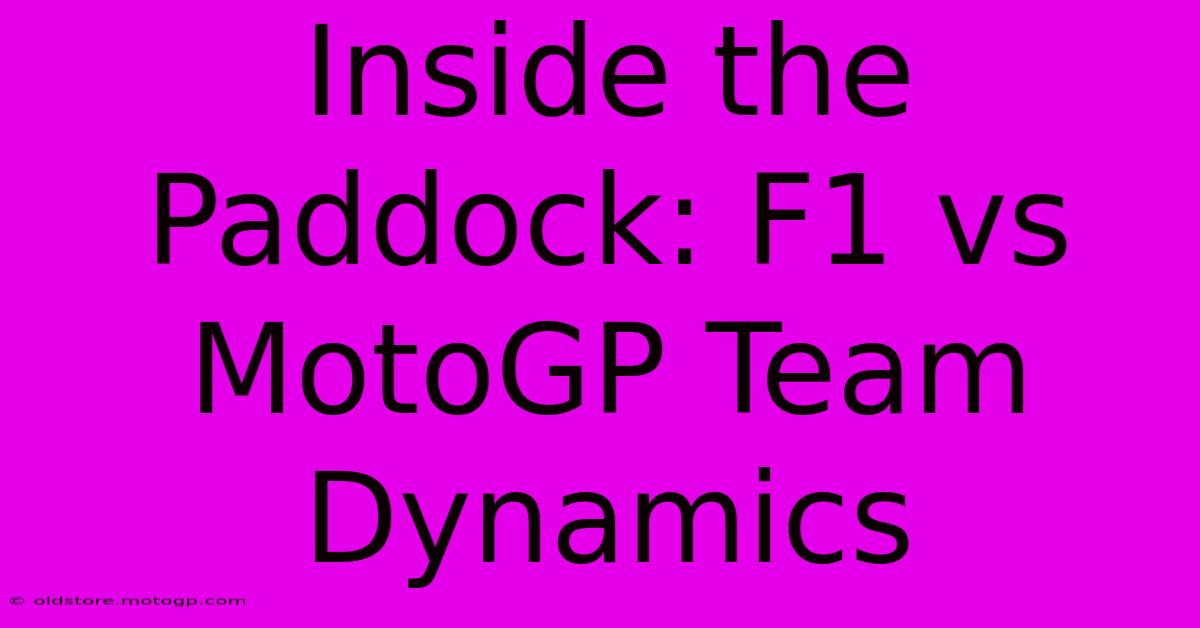Inside The Paddock: F1 Vs MotoGP Team Dynamics

Table of Contents
Inside the Paddock: F1 vs MotoGP Team Dynamics – A Tale of Two Sporting Worlds
The roar of the engines, the nail-biting finishes, the global fanbase – Formula 1 and MotoGP share undeniable similarities. But beneath the surface of high-octane thrills lies a fascinating difference in team dynamics. While both sports demand peak performance and meticulous teamwork, their organizational structures and operational approaches diverge significantly. This article delves into the contrasting team dynamics of F1 and MotoGP, exploring the nuances that shape their respective success stories.
The Heavyweight Champion: Formula 1 Team Structure
F1 teams are colossal, sophisticated operations. Think of them as miniature, highly specialized corporations. The sheer size and complexity are immediately apparent. We're talking hundreds of personnel, encompassing:
- Engineering Powerhouses: Massive engineering departments dedicated to aerodynamics, power units, chassis design, and countless other specialized areas. These teams are responsible for constant development and refinement, pushing the boundaries of technological innovation.
- Strategic Command Centers: Sophisticated race strategy teams meticulously analyze data, predict outcomes, and make crucial pit stop decisions, often impacting the race's outcome in a split second. This requires intricate communication and coordination.
- Driver Development Programs: F1 teams often invest heavily in driver academies, nurturing young talent and ensuring a pipeline of future champions. This long-term perspective is crucial for maintaining competitiveness.
- Marketing & Sponsorship Armies: The financial muscle of F1 necessitates robust marketing and sponsorship departments, ensuring that the team's brand resonates globally.
The Hierarchical Structure: F1's organizational structure is typically hierarchical, with clear lines of authority and responsibility. The Team Principal acts as the ultimate decision-maker, delegating tasks and overseeing the entire operation.
The Agile Contender: MotoGP Team Structure
In contrast, MotoGP teams operate with a more agile and streamlined structure. While still highly professional and demanding, they tend to be smaller and leaner than their F1 counterparts. This doesn't mean they lack expertise; it simply reflects a different approach:
- Rider-Centric Approach: MotoGP places significantly more emphasis on the rider's input. The rider's feedback is crucial in setting up the bike and making crucial race-day decisions. This close collaboration between rider and team is a defining characteristic.
- Close-Knit Teams: MotoGP teams often cultivate a closer, more family-like atmosphere. The smaller size fosters stronger relationships and facilitates faster communication.
- Faster Iteration Cycles: The shorter race weekends in MotoGP allow for quicker iteration and adjustments to bike setups. This demands adaptability and efficient problem-solving.
- Specialized, But Smaller Teams: While there are specialized roles (engineers, mechanics, data analysts), the team sizes are significantly smaller, resulting in more direct communication and shared responsibility.
The Flatter Hierarchy: While there's still a clear leadership structure, MotoGP teams often have a flatter hierarchy than F1, allowing for greater flexibility and quicker decision-making.
The Key Differences Summarized:
| Feature | Formula 1 | MotoGP |
|---|---|---|
| Team Size | Hundreds | Dozens to a few hundred |
| Structure | Highly hierarchical | Relatively flatter |
| Focus | Technology & Strategy | Rider feedback & Agility |
| Decision-making | Centralized | More distributed |
| Budget | Significantly larger | Smaller |
Conclusion: Adaptability Trumps Size
Ultimately, both F1 and MotoGP demonstrate that success hinges on highly effective team dynamics. However, their approaches differ significantly. F1 thrives on its sophisticated technological prowess and strategic depth, while MotoGP emphasizes the rider's integral role and the team's adaptability. Both models achieve remarkable results, proving that there isn't one "right" way to build a winning team in the world of professional motorsport. The key is finding the structure that best aligns with the sport's unique demands and maximizing the potential of its human and technological resources. The continuing rivalry between these two giants of motorsport promises many more exciting chapters to come.

Thank you for visiting our website wich cover about Inside The Paddock: F1 Vs MotoGP Team Dynamics. We hope the information provided has been useful to you. Feel free to contact us if you have any questions or need further assistance. See you next time and dont miss to bookmark.
Featured Posts
-
Moto Gp Arcade The Perfect Way To Kill Time
Feb 24, 2025
-
F1 Starting Grid The Role Of The Fia
Feb 24, 2025
-
Cota Austin Schedule Dont Miss Out
Feb 24, 2025
-
Cota Grandstands Your Guide To The Perfect View
Feb 24, 2025
-
Get Track Ready Moto Gp Helmets For Sale
Feb 24, 2025
